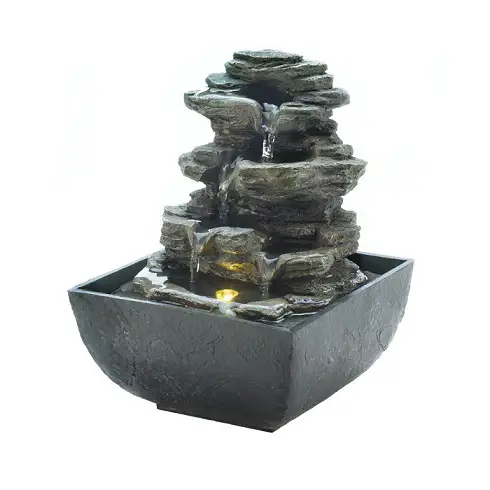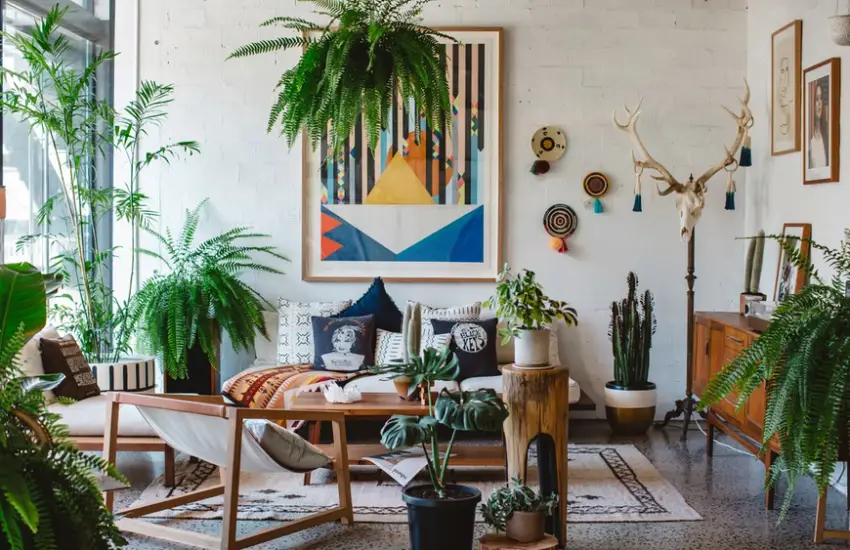Tabletop or Waterfall, Small or Big, A Guide to Buy an Indoor Fountain.
“Be a Fountain, Not a drain. Let the hatred flow and love return” – Anonymous.
Hygge is a term used in Danish for a comfortable environment at home. It really shows the importance of a relaxing and cozy environment that the Danish people actually whipped up an actual term for it. There are so many ways to introduce comfortable components to your home and, an indoor water fountain is one of them.
An indoor water fountain is a fountain that is inside your home. I mean duh! Following is the detailed guide of how you can select a perfect indoor fountain for your place. So let us dive in, not in the fountain because there is not enough water for diving. Let us dive, into the article.
Why should you keep a fountain?
- Indoor water fountains give you a relaxing environment through their beautiful water-flowing pattern. And, most importantly, through the beautiful sounds, they producethat makes you feel near to nature at your own home.
- In addition to that, you can add fairy lights or LEDs to make them more charming, welcoming, and beautiful. And so increase the appeal of your home.
- There are so many benefits of an indoor water fountain which also provide improved air quality and act as a humidifier.
- An indoor water fountain creates a relaxing environment that releases your stress and helps you sleep better.
- Pet’s love running water to drink from so, fountains can also serve as a drinking source for pets if you are not using harmful chemicals.
- The constant sound of water flowing also fades the unwanted or unpleasant sounds from surroundings.
- It adds value to your house as it needs cost and skill to install. People will appreciate and admit the value of your home.
It is good to add a buddha status near your indoor fountain, so it is also important to know the best and place. I would suggest you read my article Perfect place for the Buddha statues in your home to receive his Blessings
Types of indoor water fountain
Talking about types of indoor fountains; they are divided into three basic types that are as follows:
- Tabletop Fountains
- Floor Fountains
- Wall Mounted Fountains
Tabletop Fountains
Our Recommendations
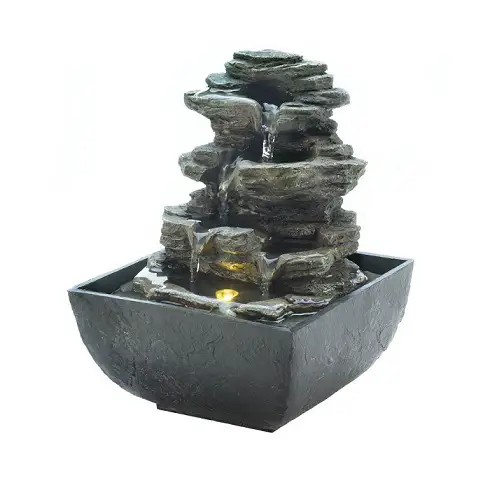
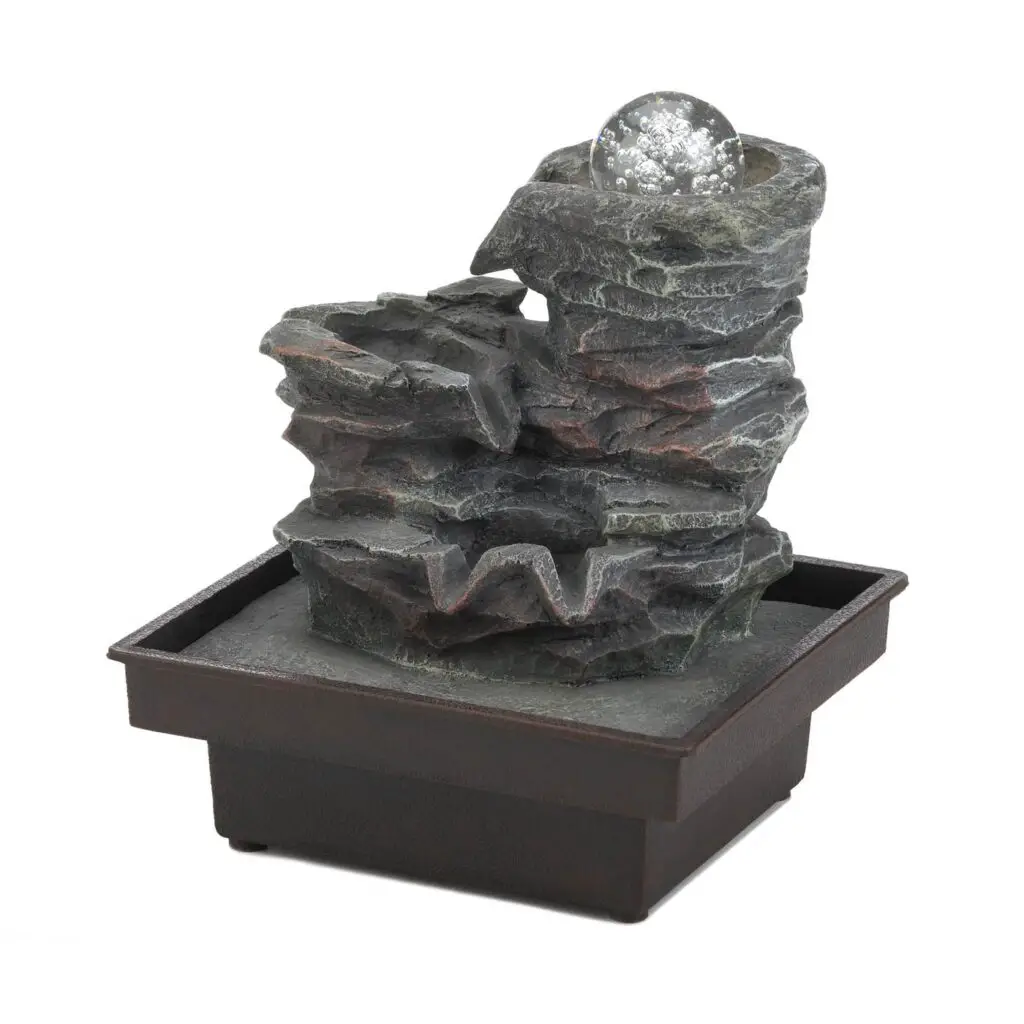
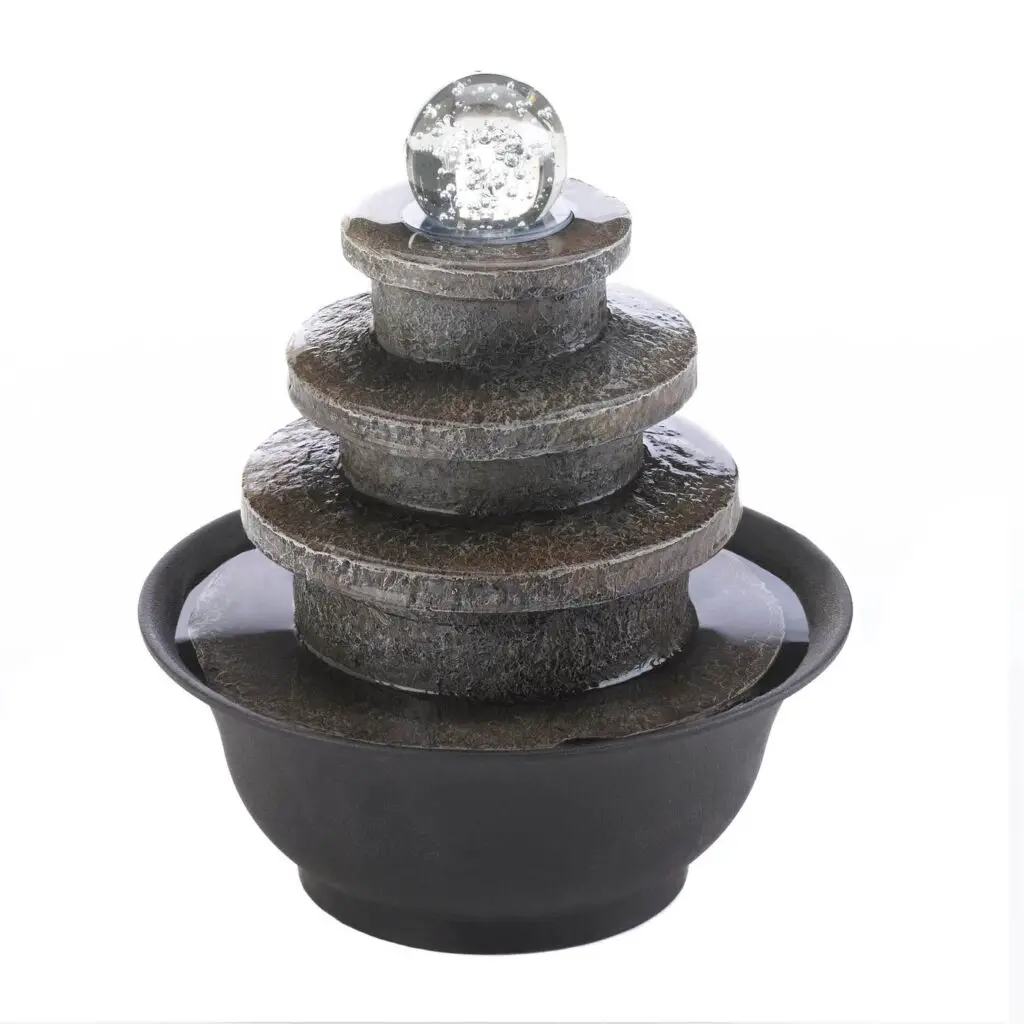
As a name suggests, you can legit put them on top of a small table. They are portable, easy to carry and adjust, can be kept in small spaces. You can keep them on coffee tables, countertops, desks, or an end table. They work on a simple principle a small pump is hidden under rocks and other decorations. The pump pumps water towards the top. The water flows down and gathers in the pump, which is then again pumped up and so forth.
Wall-mounted fountains
As the name suggests, wall-mounted fountains are fitted on the walls with the help of brackets. The brackets are made of strong materials like copper or steel. They are rectangular in shape to adjust to the shape of walls. They can be horizontally or vertically latched onto the walls, depending on your preference. They have a pump, in the lower bracket. The water moves up from itand then back. They are pretty and huge but popular and common.
Floor Fountains
These fountains are similar to the wall-mounted ones. But they are placed on the floor. In addition to the floor, they can be kept on lobbies, decks, patios, and entryways. The design and size can be customized and adjusted as per your preference. They work on the same principle as the rest. A simple pump installed in the fountain pumping water from downwards to upwards and then receiving it back.
Our Recommendations

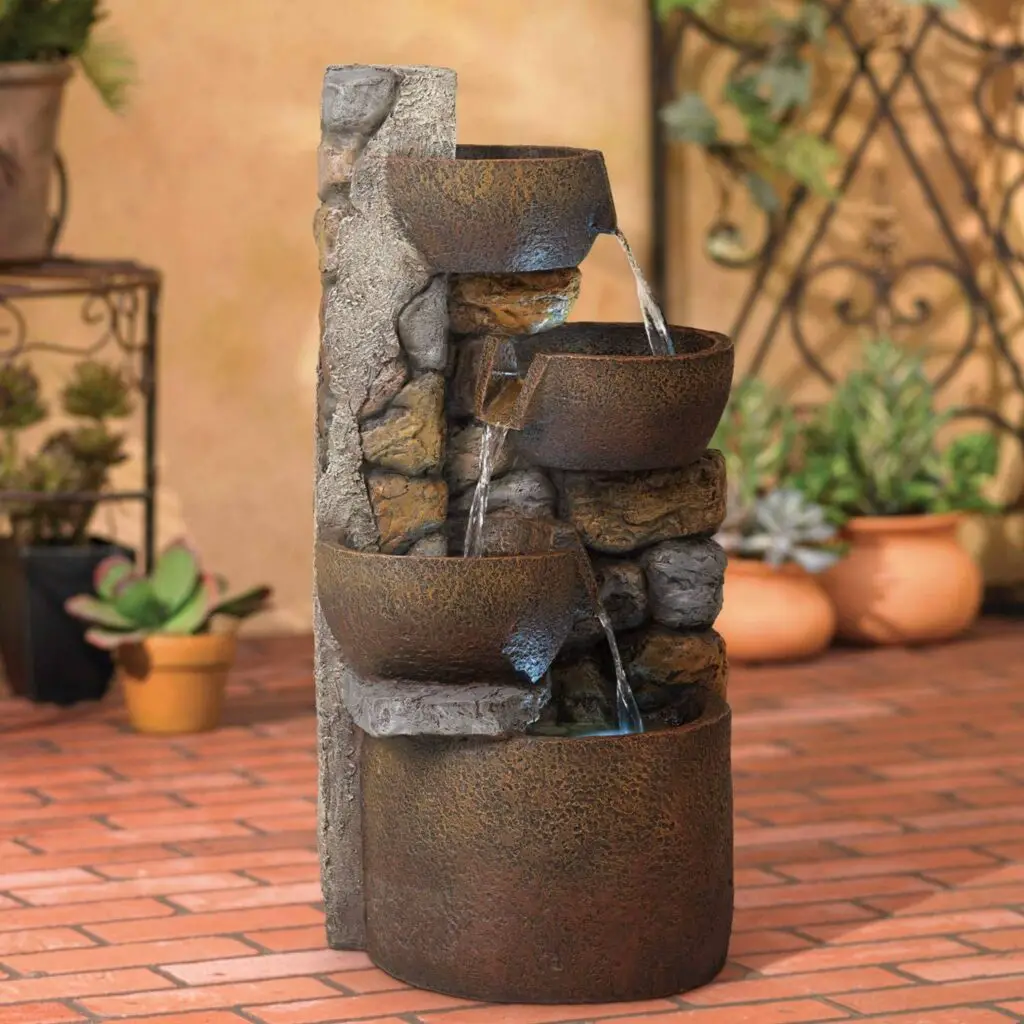
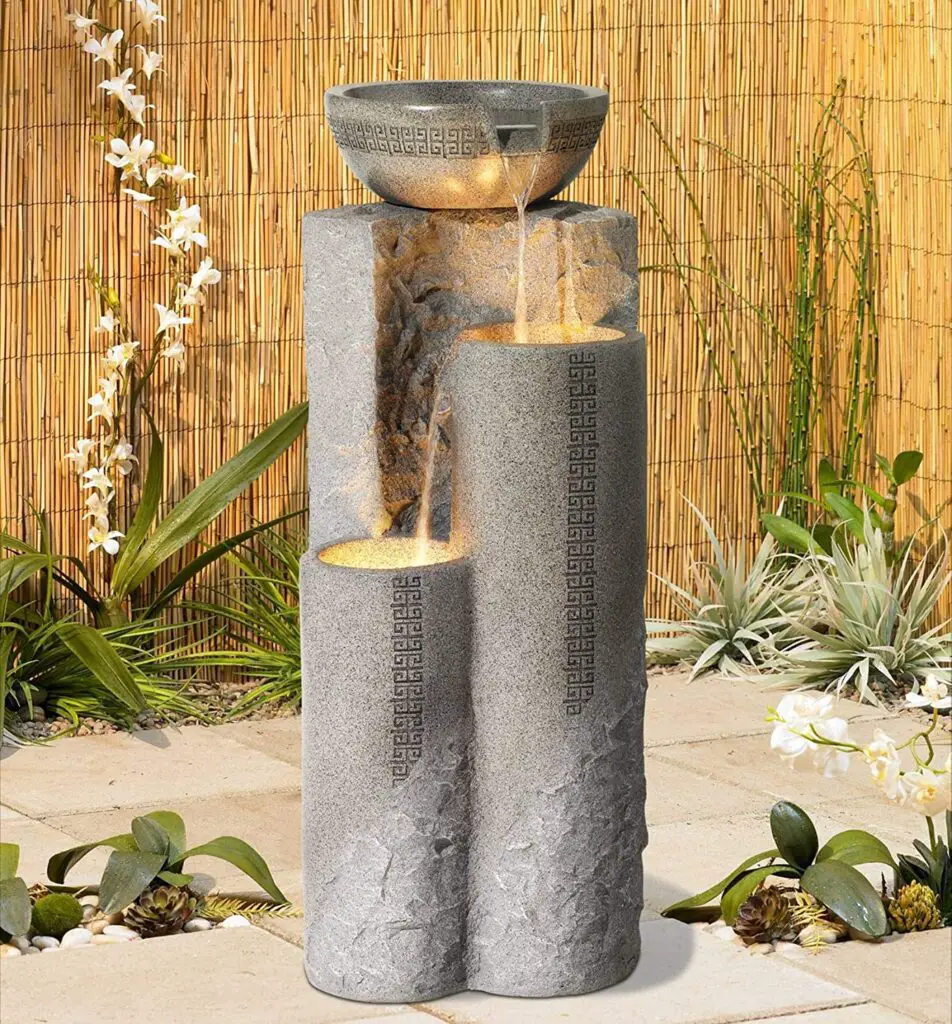
It is very vital to choose the right type of fountain for you. For example, the tabletop is reasonable for small spaces and congested areas and is budget-friendly. Floor fountains and wall-mounted ones are no doubt expensive but are grand and placed at a central place in the room to be an attention-seeking entity.
Materials of the fountain
Copper
Copper has a distinct royal color that gives an expensive finish to everything it is used to make. It is very common in fountains and is very durable with high strength. It is resistant to weathering because water is rippling out of the fountains. It doesn’t absorb moisture and doesn’t corrode easily. It is cheap as compared to other metals and so a good option to consider a fountain made of copper. But copper is metallic and can have sharp edges that can dangerous to children playing around with the fountains so, it should be kept in a place where it is safe from your child’s access for their own safety. Plus, it can echo along the water rippling through, it will give out a unique and soothing sound.
Marble
Marble is a metamorphic rock. The metamorphic word denotes a layer of earth from which marble is extracted. It is strong and gives the raw finish to the final product. It is none foliated substance which means that it does not have layers within it. It does not appear to have bands. It appears as one solid block of material. One thing that comes to mind is that it is just a rock … can it compete with a metal like copper? As a matter of fact, the Taj Mahal was solely made of Marble stone and is standing still in all its grandeur after so many years of weathering and extreme temperature in India. So marble is a very durable option to choose from. No sharp edges like in copper marble give a very old-school look to the fountains. Although it is a raw material, it has bold patterns and makes your foundation very attractive and unique. A good option for contemporary yet trendy homes. You can match the traditional setting of your home with an old-age rock fountain. Or, you can add contrast to your stylish and modern home with a marble fountain.
Mirror
A mirror may seem a simple material and can be found anywhere. Your own home would have many mirrors, what’s new in that?. A mirror can be a very nice and decent option for your indoor fountain. It is subtle material but, it can make a huge impact when you add water along with it. Mirror and water are a unique combination. Mirror has a reflective surface so; it would make water shine and the drops twinkle. As it reflects, the reflection makes any place look bigger than it actually is. It is helpful when you have a small studio apartment or a small room. But it would look good in a big room likewise. The reflection makes a sprawling place relaxing and calm and can make you happier. It would give your place an expensive look. The sounds of rippling water can have a soothing effect, and reflections from the mirror would be an added bonus. A very reasonably priced and satisfactory option for an indoor fountain.
Slate
It is a metamorphic rock like marble, but it is foliated. It means that the slate would have layers and layers of material. It is a natural material made after the accumulation of materials over many years hence the layering. The layers in slate make it a unique material. This means that no two pieces of slate would be the same in appearance even if they are of the same style. The layering gives the slate a unique and dense appearance. A rich texture of slate is perfect to add a unique and special piece of fountain in your home. It is strong because it consists of many different elements combined together to form a composite. A composite has the combined strength of all the elements making it. It might contain hematite, graphite, calcite, chlorite, quartz, and many other naturally existing elements. It will surely give an organic and earthy touch to your home if you choose a fountain of this material.
How to install an indoor fountain?
Setting up an indoor fountain is easy and can be done by following the below easy steps.
Assembling:
It involves putting together all of the equipment and parts. The parts that need assembling include:
- A base reservoir
- Fountain Head
- Pump and tubing
- Any decorative material
Follow the instructions carefully while assembling the fountain. The pool of the fountain that contains the reservoir is the base of the fountain. Set the pump in the reservoir and, if the pump has a suction cup to keep it in place, that would be helpful. Now look at the adjustment dial of your pump and examine it. Learn how to use it after it is covered in water and other decorative stuff.
Watering
Add water into the base containing the pump and the reservoir. The water level should be less than one inch of the base so that water does not spill out from the fountain base when the pump works. But water should be enough to completely submerge the pump. Now, if you use demineralized water, it would be better as mineral deposits with time can affect the performance of your fountain. Add Protec if you can. It would prevent the white deposits from resulting in the pool.
Adjust the pump and plugin
Make two things sure that your hands are dry, and the pump is completely submerged in the water before running it. Dry your hands and the cable before plugging in it the electrical power source. After plugging in, the pump would start working. You need to adjust the rate of pumping of water. The water flow from the pump can be adjusted according to your preference how fast or slow you want it.
Surrounding materials
You can use pebbles, stones, and leaves to decorate your fountain. Make sure the material does not come in the way of your fountain pump, it may divert the water flow direction. Also, make sure there is no material that can become entrapped in the pump to affect its working.
Cleaning and maintenance
Keeping your fountain clean is very important as it prevents dangerous build-up of materials and microorganisms.
- Turn the fountain off.
- If there are stones in your fountain and leaves and other decorative materials, take them out. You need to clean them as well.
- Remove the pump because that also needs to be cleaned.
- Clean the fountain in the sink. For the wall fountain, take a non-abrasive sponge and soap water and clean the inside of the pan. Use mild soap so to remove any stains. Make sure the outside is also dry after cleaning.
- Scrub if you need to clean out the algae built up because they can destroy the look of your fountain.
- Algae built up can be dangerous for your fountain and to stop it from building up altogether is to use a compound like Protec, that puts a stop to the formation of these and any other mineral build-up.
- Best of all is to add a cup or two of Apple cider vinegar, which is an antiseptic, antibacterial, and anti-antiviral agent. It would also keep your fountain water fresh.
Cleaning pump of the fountain
To clean the pump, take the pump out of the fountain into the sink and open it, you should be able to open the pump. Now take a toothbrush and gently rinse out the holes through which the water flows out to clear out any debris built up. Put the pump back together and into the clean fountain.
Winterizing tips
If you live in cold areas, it can get extremely cold in the winters. The water in your fountains can freeze up. If you want to protect it from water freeze up in the winter, you need to winterize your fountain. The water can freeze up and crack your fountain. First, remove the pump and drain out all the water from the fountain. Clean the fountain and completely dry it as minute water crystals can destroy your fountain too. Then cover it to prevent water accumulation.
If you would like to add an outdoor fountain in your garden then you must read my article on Your Queries for an outdoor fountain.
Experts Advice
Keeping an indoor fountain is very useful to create a scenic and decent view of your home. But there are some things to be considered while buying and installing the fountain. This article would surely help you address all your needs and concerns while getting an indoor fountain. So, give this article a thorough read and clear out all the ambiguities. Happy fountaining!

